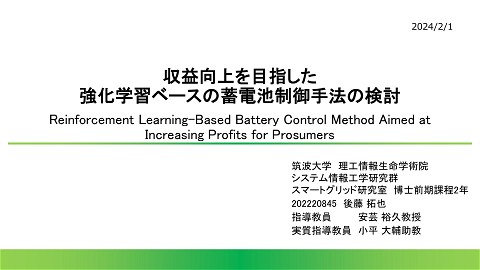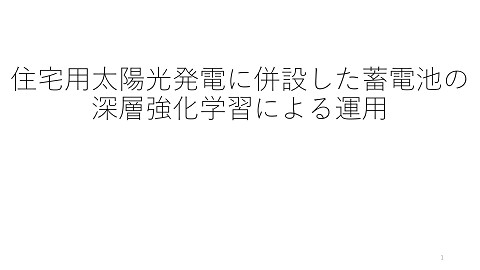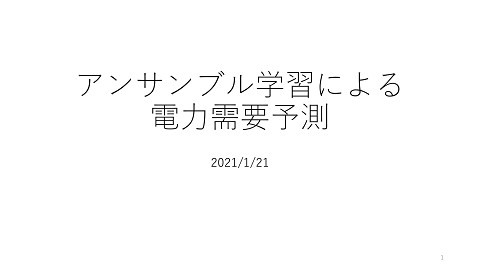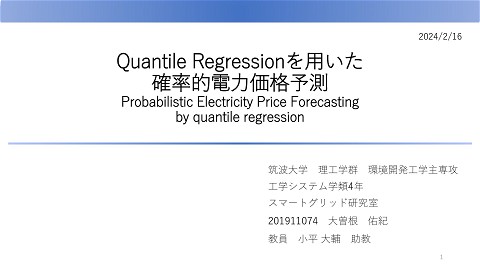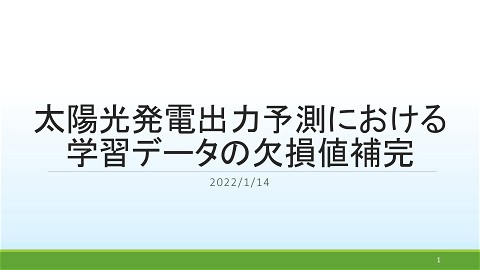2000_Battery Degradation Platform and Model for Realistic Battery Use Cases
201 Views
March 31, 22
スライド概要
D. Kodaira and S. Han, "Battery Degradation Platform and Model for Realistic Battery Use Cases," 2020 4th International Conference on Smart Grid and Smart Cities (ICSGSC), 2020, pp. 14-17, doi: 10.1109/ICSGSC50906.2020.9248541.
小平大輔 - 筑波大学エネルギー・環境系助教。現在の研究テーマは、電気自動車の充電スケジューリング、エネルギー取引のためのブロックチェーン、太陽光発電とエネルギー需要の予測など。スライドの内容についてはお気軽にご相談ください:kodaira.daisuke.gf[at]u.tsukuba.ac.jp
関連スライド
各ページのテキスト
1 Battery Degradation Platform and Model for Realistic Battery Use Cases Daisuke Kodaira Assistant Professor Tokyo University of Science, Japan Tokyo University of Science
Problems caused by Photovoltaic(PV) generation Low Voltage network High Voltage network Local Subst ations Consumption Conventional Generation Long Distance T ransmission Local distribution Present Day Large Desert PV Plants Tokyo University of Science Copyright © PSSENL All Rights Reserved
Problem in High Voltage network Local Substations Without PV With PV Demand [MW] 8.5 8 7.5 7 1) Excessive generation 6.5 2) Demand Rump-up 6 0:00 6:00 12:00 18:00 0:00 Batteries can contribute flat demand profile … How about the cost? … How many years is the battery long? Battery Degradation Tokyo University of Science Copyright © PSSENL All Rights Reserved
State of Health (SOH) Question. If we run a battery with the specific profile, how much the battery life will be shortened? State of Health (SOH) is widely used to evaluate battery life. 𝑆𝑂𝐻[%] = 𝐶𝑟 × 100 𝐶𝑓 𝐶𝑟 : 𝑟𝑒𝑚𝑎𝑖𝑛𝑖𝑛𝑔 𝑒𝑛𝑒𝑟𝑔𝑦 𝐴ℎ 𝑜𝑓𝒖𝒔𝒆𝒅 𝑏𝑎𝑡𝑡𝑒𝑟𝑦 𝑎𝑡 𝑆𝑜𝐶 100% 𝐶𝑓 : 𝑟𝑒𝑚𝑎𝑖𝑛𝑖𝑛𝑔 𝑒𝑛𝑒𝑟𝑔𝑦 𝐴ℎ 𝑜𝑓 𝒇𝒓𝒆𝒔𝒉 𝑏𝑎𝑡𝑡𝑒𝑟𝑦 𝑎𝑡 𝑆𝑜𝐶 100% 𝑆𝑜𝐶 100% 𝑆𝑜𝐶 100% 1000 Cycles…. 𝐶𝑓 = 10Ah 𝐶𝑟 = 8Ah 𝑆𝑂𝐻 = 80% SOH is index of the state comparing with the fresh battery. We cannot estimate how much the battery gets damaged with various conditions Tokyo University of Science Copyright © PSSENL All Rights Reserved
Factors of battery degradation We need to build a model to estimate battery degradation. Mainly 3 conditions are related to degradation. Oxidation of Electrolyte Temperature C-rate (Current) Electrolyte Decomposition Electrode Decomposition Lithium Plating Intercalation Gradients Formation of Li grains Operating SOC Current Collector Corrosion Crystal Structure Disorder Binder Decomposition Electrode Decomposition Tokyo University of Science Copyright © PSSENL All Rights Reserved
SOH Estimation vs Wear Density Function We proposed Wear Density Function (WDF) [1] WDF WDF provides how much a battery ages due to the charge with various conditions SOH WDF Remaining Life 10 Ah 10 Ah Temperature 25℃ Any degree Current 10A Any current Operating SOC Always 100% to 0% Any SOC area WDF is for evaluating arbitral battery charging profile [1] S. Han, S. Han, and H. Aki, “A practical battery wear model for electric vehicle charging applica tions,” Appl. Energy, vol. 113, pp. 1100–1108, Jan. 2014. Tokyo University of Science Copyright © PSSENL All Rights Reserved
Constructing SOH platform based on big data Example of the Wear Density Function in a discrete manner Operation SOC range 100% 100% 𝑡𝑜 90% ΔEnergy [Ah] temp [℃] 10 20 … 490 500 510 … 990 1000 0% … 100% -5 -4 … 25 26 27 … 39 40 60% 𝑡𝑜 50% Current [A] 0.1 0.2 … 1.0 1.1 1.2 … 2.9 3.0 𝑊𝑖,1 𝑊𝑖,2 … 𝑊𝑖,500 𝑊𝑖,501 𝑊𝑖,502 … 𝑊𝑖,𝑝−1 𝑊𝑖,𝑝 Δ𝐷𝑒𝑔𝑟𝑎𝑑𝑎𝑡𝑖𝑜𝑛 = 𝑊𝑖 ,1 ∗ 10 + 𝑊𝑖 ,2 ∗ 20 + ⋮ + 𝑊𝑖 ,𝑝 ∗ ΔEnergy 0% Collect from client’s batteries 7 Calculate the degree of degradation Copyright © PSSENL All Rights Reserved
Constructing SOH platform based on big data Operation SOC range 100% 100% 𝑡𝑜 90% If we have weight vector 𝑊, we can estimate proper degradation for arbitral charging schedules with various conditions ΔEnergy [Ah] temp [℃] 10 20 … 490 500 510 … 990 1000 0% … 100% -5 -4 … 25 26 27 … 39 40 Current [A] 0.1 0.2 … 1.0 1.1 1.2 … 2.9 3.0 𝑊𝑖,1 𝑊𝑖,2 … 𝑊𝑖,500 𝑊𝑖,501 𝑊𝑖,502 … 𝑊𝑖,𝑝−1 𝑊𝑖,𝑝 Δ𝐷𝑒𝑔𝑟𝑎𝑑𝑎𝑡𝑖𝑜𝑛 = 𝑊𝑖,1 ∗ Δ𝐸𝑛𝑒𝑟𝑔𝑦 + 𝑊𝑖,2 ∗ Δ𝐸𝑛𝑒𝑟𝑔𝑦 +…… 60% 𝑡𝑜 50% 0% Collect from client’s batteries 8 Calculate the degree of degradation Copyright © PSSENL All Rights Reserved
Constructing SOH platform based on big data Gather the conditions information from clients Operation SOC range 100% 100% 𝑡𝑜 90% ΔEnergy [Ah] temp [℃] 10 20 … 490 500 510 … 990 1000 0% … 100% -5 -4 … 25 26 27 … 39 40 Current [A] 0.1 0.2 … 1.0 1.1 1.2 … 2.9 3.0 Measure the damage from client systems 𝑊𝑖,1 𝑊𝑖,2 … 𝑊𝑖,500 𝑊𝑖,501 𝑊𝑖,502 … 𝑊𝑖,𝑝−1 𝑊𝑖,𝑝 Δ𝐷𝑒𝑔𝑟𝑎𝑑𝑎𝑡𝑖𝑜𝑛 = 𝑊𝑖,1 ∗ Δ𝐸𝑛𝑒𝑟𝑔𝑦 + 𝑊𝑖,2 ∗ Δ𝐸𝑛𝑒𝑟𝑔𝑦 +…… 60% 𝑡𝑜 50% 0% Calculate W Collect from client’s batteries 9 Calculate the degree of degradation Copyright © PSSENL All Rights Reserved
Research Objective Example of the Wear Density Function matrix -> Our final goal is calculate 𝑤𝑒𝑖𝑔ℎ𝑡 𝑣𝑒𝑐𝑡𝑜𝑟 𝑥 Estimated battery degradation based on another method [2] (Given data) Weight vector (Unknown) Energy transition (Given data) 𝑊1,1 Profile No.1 ∆𝑞11 ∆𝑞21 ∆𝑞31 ∆𝑞41 𝑊1,2 Profile No.2 ∆𝑞12 ∆𝑞22 ∆𝑞32 ∆𝑞42 𝑊1,3 𝐴 ∆𝐷𝑎𝑚𝑎𝑔𝑒 = ∆𝐷𝑎𝑚𝑎𝑔𝑒 𝑊1,4 𝐵 𝑥 𝐴𝑥 = 𝐵 𝑥 = 𝐴−1 𝐵 [2] S. Han, “Apparatus and method for real-time estimation of battery state-of-health”, patent KR101615139B1, 2014 Tokyo University of Science Copyright © PSSENL All Rights Reserved
Constructing SOH platform based on big data • Sending battery management section’s information such as current, temperature, and discharge amount (∆𝐴ℎ) to a server • Estimating current Capacity Retention [Ah] in real time based on the battery terminal voltage [1] • The server estimates WDF function based by accumulated data Based on the collected data, apply with WDF to reflect the sensitive deterioration degree to the app by making deterioration degree per user’s pattern into big-data Data transmission Data transmission server Wireless network Car & application Analyzing big data Collecting data such as estimated deterioration degree, current, voltage, running pattern, temperature, etc. Estimate deterioration degree by Cycle life Evaluation Function *Capacity Retention; The amount of provided energy [Ah] when the battery discharges from SOC 100% to 0% [1] S. Han, “Apparatus and method for real-time estimation of battery state-of-health”, patent KR101615139B1, 2014 Tokyo University of Science Copyright © PSSENL All Rights Reserved
Data example to get WDF *Capacity Retention; The amount of provided energy [Ah] when the battery discharges from SOC 100% to 0% ∆𝐸𝑛𝑒𝑟𝑔𝑦 [Ah] 3 5 4 ∆𝑞1,2 ∆𝑞2,2 ∆𝑞3,2 ⋮ Initial SOC [%] 100 75 50 ⋮ ⋮ ⋮ ⋮ Final SOC [%] 75 50 25 ⋮ ⋮ ⋮ ⋮ Used energy Temperature [C] 40 30 20 ⋮ ⋮ ⋮ ⋮ Current [A] 2.0 1.3 1.6 ⋮ ⋮ ⋮ ⋮ Weight 𝑊1 𝑊2 𝑊3 𝑊1 𝑊2 𝑊3 ⋮ Condition information 3 ∆𝑞1,2 ⋮ 5 4 𝑊1 ∆𝑞2,2 ∆𝑞3,2 𝑊2 ⋮ 𝐴 ⋮ 𝑊3 𝑥 ∆Capacity Retention [Ah] 0.4 Continuous one profile from a user ∆𝐶𝑅2 ⋮ Degradation 0.4 = ∆𝐶𝑅2 ∆𝐶𝑅3 𝐵 = 𝑥 = 𝐴−1𝐵 Once we calculate 𝑤𝑒𝑖𝑔ℎ𝑡 𝑣𝑒𝑐𝑡𝑜𝑟 𝒙, we can estimate degradation for arbitral charging/discharging profile with various conditions Tokyo University of Science Copyright © PSSENL All Rights Reserved
The pseudo experiment data Distribution of data set (follows normal distribution) Temperature Tokyo University of Science C-rate Copyright © PSSENL All Rights Reserved
The pseudo experiment data Initial SOC Final SOC ∆𝐂𝐚𝐩𝐚𝐜𝐢𝐭𝐲 𝐫𝐞𝐭𝐞𝐧𝐭𝐢𝐨𝐧 Classify all the data set with 3 groups using k-means algorithm -> Consider 3 conditions! Tokyo University of Science Copyright © PSSENL All Rights Reserved
Simulation result to get WDF example 3 ∆𝑞1,2 ⋮ 5 4 𝑊1 ∆𝑞2,2 ∆𝑞3,2 𝑊2 ⋮ ⋮ 𝐴 0.4 = ∆Energy matrix (k=3) ∆𝐶𝑅3 𝑊3 𝑥 ∆𝐶𝑅2 = ∆𝐶𝑅 matrix 𝐵 𝑊1 = 0.465 ∗ 10−4 𝑊2 =0.957 ∗ 10−4 = inverse 𝑊3 =1.173 ∗ 10−4 We got WDF matrix as the number of W Tokyo University of Science Copyright © PSSENL All Rights Reserved
Thank you Tokyo University of Science 16 Copyright © PSSENL All Rights Reserved

